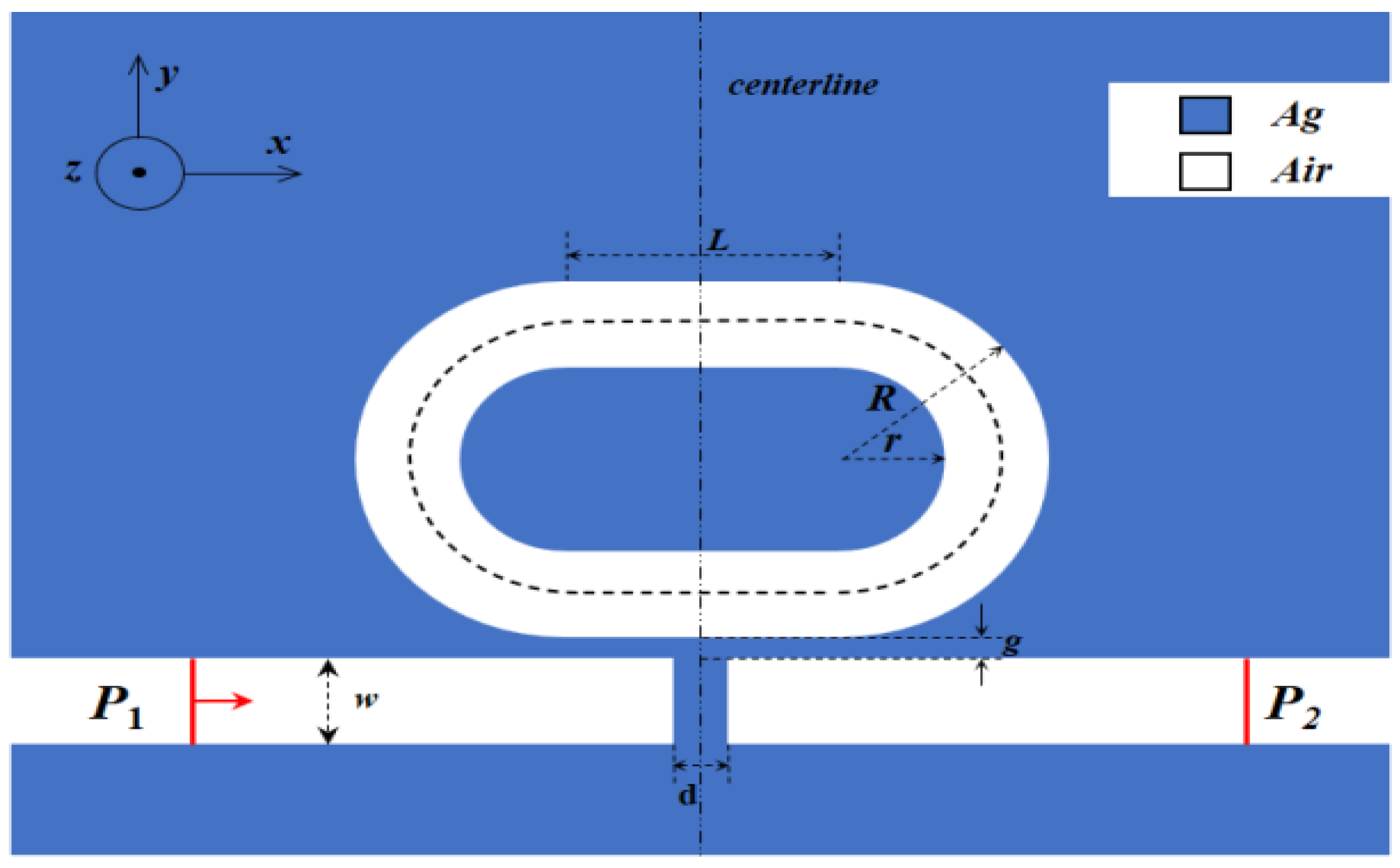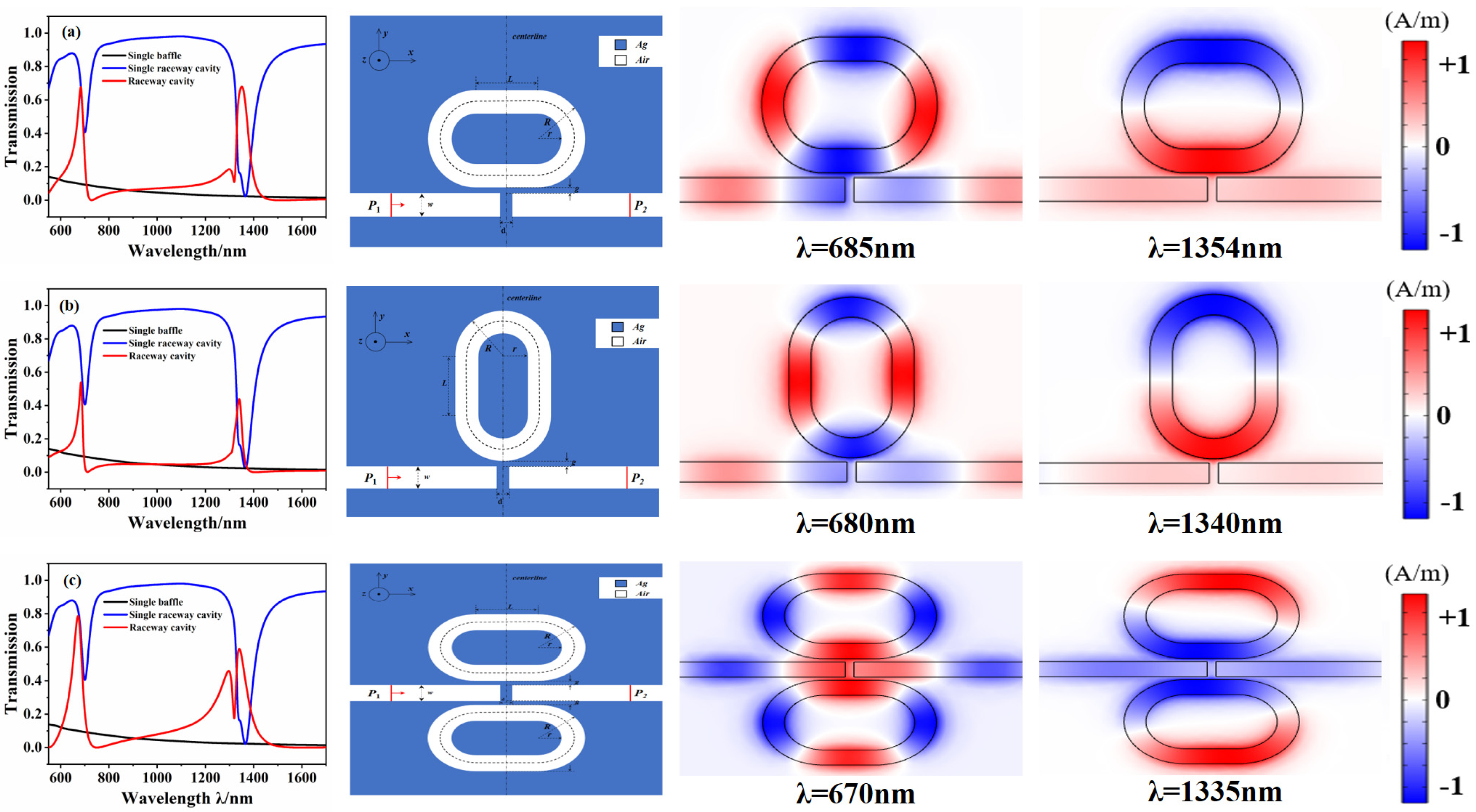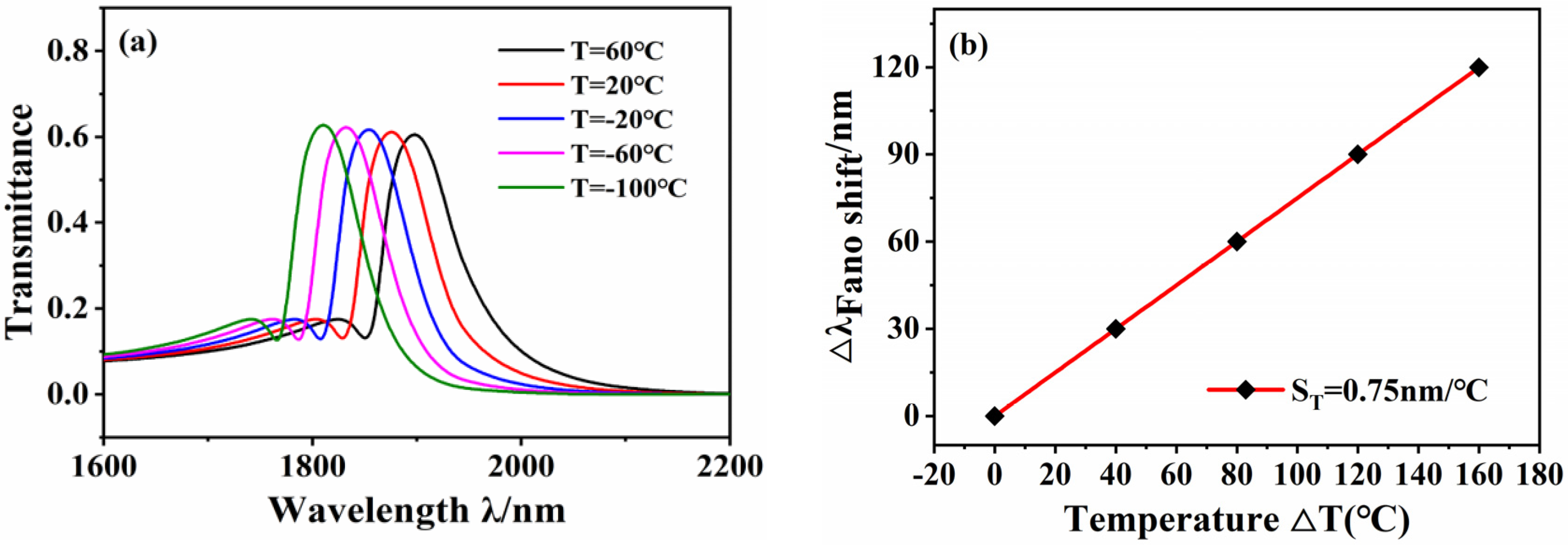Research on Fano Resonance Sensing Characteristics Based on Racetrack Resonant Cavity
Abstract
:1. Introduction
2. Model Building and Theory
2.1. Model Building
2.2. Fano Resonance Principle Analysis
3. Structural Analysis
4. Sensing Application
5. Conclusions
Author Contributions
Funding
Data Availability Statement
Acknowledgments
Conflicts of Interest
References
- Barnes, W.L.; Dereux, A.; Ebbesen, T.W. Surface Plasmon Subwavelength Optics. Nature 2003, 424, 824–830. [Google Scholar] [CrossRef] [PubMed]
- Yue, T.; Zhang, Z.; Wang, R. Refractive Index Sensor Based on Fano Resonances in Metal-Insulator-Metal Waveguides Coupled with Resonators. Sensors 2017, 17, 784. [Google Scholar]
- Hsieh, L.Z.; Chau, Y.; Lim, C.M. Metal nano-particles sizing by thermal annealing for the enhancement of surface plasmon effects in thin-film solar cells application. Opt. Commun. 2016, 370, 85–90. [Google Scholar] [CrossRef]
- Sung, M.J.; Ma, Y.F.; Chau, Y.F. Surface plasmon resonance in a hexagonal nanostructure formed by seven core shell nanocylinders. Appl. Opt. 2010, 49, 920–926. [Google Scholar] [CrossRef]
- Chau, Y.F.; Jiang, Z.H. Plasmonics Effects of Nanometal Embedded in a Dielectric Substrate. Plasmonics 2011, 6, 581–589. [Google Scholar] [CrossRef]
- Sarkaleh, A.K.; Lahijani, B.V.; Saberkari, H. Optical Ring Resonators: A Platform for Biological Sensing Applications. J. Med. Signals Sens. 2017, 7, 185–191. [Google Scholar] [CrossRef] [PubMed]
- Tsigaridas, G.N. A study on refractive index sensors based on optical micro-ring resonators. Photonic Sens. 2017, 3, 217–225. [Google Scholar] [CrossRef]
- Zhang, Z.; Shi, F.; Chen, Y. Tunable Multichannel Plasmonic Filter Based on Coupling-Induced Mode Splitting. Plasmonics 2015, 10, 139–144. [Google Scholar] [CrossRef]
- Wang, S.; Li, Y.; Xu, Q. A MIM Filter Based on a Side-Coupled Crossbeam Square-Ring Resonator. Plasmonics 2016, 11, 1291–1296. [Google Scholar] [CrossRef]
- Ma, F.S.; Lee, C. Optical Nanofilters Based on Meta-Atom Side-Coupled Plasmonics Metal-Insulator-Metal Waveguides. J. Lightwave Technol. 2013, 31, 2876–2880. [Google Scholar] [CrossRef] [Green Version]
- Veronis, G.; Fan, S. Bends and splitters in metal-dielectric-metal subwavelength plasmonic waveguides. Appl. Phys. Lett. 2005, 87, 131101–131103. [Google Scholar] [CrossRef]
- Lin, W.; Wei, L. Tunable control of electromagnetically induced transparency analogue in a compact graphene-based waveguide. Opt. Lett. 2015, 40, 2325–2328. [Google Scholar]
- Li, H.J.; Wang, L.L.; Xiang, Z. Plasmonically Induced Absorption and Transparency Based on MIM Waveguides with Concentric Nanorings. IEEE Photonic Technol. Lett. 2016, 28, 1454–1457. [Google Scholar] [CrossRef]
- Gao, Y.; Zhan, S.; Liu, Q.; Liu, Y. Controllable plasmonic sensing based on Fano resonance in a cavity coupled defective MDM waveguide. J. Phys. D Appl. Phys. 2016, 49, 265109. [Google Scholar] [CrossRef]
- Miroshnichenko, A.E.; Flach, S.; Kivshar, Y.S. Fano resonances in nanoscale structures. Rev. Mod. Phys. 2009, 82, 2257–2298. [Google Scholar] [CrossRef] [Green Version]
- Qi, J.; Chen, Z.; Chen, J. Independently tunable double Fano resonances in asymmetric MIM waveguide structure. Opt. Express 2014, 22, 14688–14695. [Google Scholar] [CrossRef]
- Pang, S.; Huo, Y.; Xie, Y.; Hao, L. Tunable Electromagnetically Induced Transparency-Like in Plasmonic Stub Waveguide with Cross Resonator. Plasmonics 2017, 12, 1161–1168. [Google Scholar] [CrossRef]
- Mirin, N.A.; Bao, K.; Nordlander, P. Fano Resonances in Plasmonic Nanoparticle Aggregates. J. Phys. Chem. A 2009, 113, 4028–4034. [Google Scholar] [CrossRef] [PubMed]
- Chang, W.S.; Lassiter, J.B.; Swanglap, P. A Plasmonic Fano Switch. Nano Lett. 2012, 12, 4977–4982. [Google Scholar] [CrossRef]
- Li, Z.; Cakmakyapan, S.; Butun, B. Fano resonances in THz metamaterials composed of continuous metallic wires and split ring resonators. Opt. Express 2014, 22, 26572–26584. [Google Scholar] [CrossRef] [Green Version]
- Zi-Hua, L.; Zheng, L. Plasmonics refractive index sensor based on tunable ultra-sharp Fano resonance. Optoelectron. Lett. 2018, 14, 421–424. [Google Scholar]
- Zhang, Y.; Kuang, Y.; Zhang, Z. High-sensitivity refractive index sensors based on Fano resonance in the plasmonic system of splitting ring cavity-coupled MIM waveguide with tooth cavity. Appl. Phys. 2019, 125, 13. [Google Scholar] [CrossRef]
- Yang, J.; Song, X.; Chen, Z. Tunable Multi-Fano Resonances in MDM-Based Side-Coupled Resonator System and its Application in Nanosensor. Plasmonics 2017, 12, 1665–1672. [Google Scholar] [CrossRef]
- Manolatou, C.; Khan, M.J.; Fan, S. Coupling of modes analysis of resonant channel add-drop filters. IEEE J. Quantum Electron. 1999, 35, 1322–1331. [Google Scholar] [CrossRef] [Green Version]
- Liu, D.; Fu, W. Plasmon-Induced Transparency and Refractive Index Sensing Based on a Trapezoid Cavity Coupled with a Hexagonal Resonator. Plasmonics 2019, 14, 663–671. [Google Scholar] [CrossRef]
- Zhao, C.; Song, X.; Duan, G. Multiple Fano Resonances Control in MIM Side-Coupled Cavities Systems. IEEE Photonics J. 2015, 7, 1–10. [Google Scholar]
- Chen, F.; Zhang, H.; Sun, L. Temperature tunable Fano resonance based on ring resonator side coupled with a MIM waveguide. Opt. Laser Technol. 2019, 116, 293–299. [Google Scholar] [CrossRef]
- Chou, Y.F.; Chao, C.; Huang, H.J. Ultrawide Bandgap and High Sensitivity of a Plasmonic Metal-Insulator-Metal Waveguide Filter with Cavity and Baffles. Nanomaterials 2020, 10, 2030. [Google Scholar] [CrossRef]
- Zhu, J.; Lou, J. High-sensitivity Fano resonance temperature sensor in MIM waveguides coupled with a polydimethylsiloxane-sealed semi-square ring resonator. Results Phys. 2020, 18, 103183. [Google Scholar] [CrossRef]
- Wu, T.; Liu, T. A nanometeric temperature sensor based on plasmonic waveguide with an ethanol-sealed rectangular cavity. Opt. Commun. 2015, 339, 1–6. [Google Scholar] [CrossRef]
- Kekatpure, R.D.; Hryciw, A.C.; Barnard, E.S. Solving dielectric and plasmonic waveguide dispersion relations on a pocket calculator. Opt. Express 2009, 17, 24112–24129. [Google Scholar] [CrossRef] [PubMed] [Green Version]
- Gai, H.; Wang, J.; Qian, T. Modified Debye model parameters of metals applicable for broadband calculations. Appl. Opt. 2007, 46, 2229–2233. [Google Scholar] [CrossRef] [PubMed]
- Chau, Y.F.C.; Chou, C.C.T. Improved Refractive Index-Sensing Performance of Multimode Fano-Resonance-Based Metal-Insulator-Metal Nanostructures. Nanomaterials 2021, 11, 2097. [Google Scholar] [CrossRef]
- Chen, Y.; Chen, L.; Wen, K. Multiple fano resonances in a coupled plasmonic resonator system. J. Appl. Phys. 2019, 126, 083102. [Google Scholar] [CrossRef]
- Butt, M.A.; Kazanskiy, N.L.; Khonina, S.N. Highly integrated plasmonic sensor design for the simultaneous detection of multiple analytes. Curr. Appl. Phys. 2020, 20, 1274–1280. [Google Scholar] [CrossRef]
- Chao, C. Highly Sensitive and Tunable Plasmonic Sensor Based on a Nanoring Resonator with Silver Nanorods. Nanomaterials 2020, 10, 1399. [Google Scholar] [CrossRef]
- Yan, S.; Zhang, M. Refractive Index Sensor Based on a Metal–Insulator–Metal Waveguide Coupled with a Symmetric Structure. Sensors 2017, 17, 2879. [Google Scholar] [CrossRef] [Green Version]
- Fan, J.; Zhang, J.; Ping, L. A single-mode fiber sensor based on core-offset inter-modal interferometer. Opt. Commun. 2014, 320, 33–37. [Google Scholar] [CrossRef]
- Xuguang, H. Simultaneous measurement of refractive index and temperature based on asymmetric structures modal interference. Opt. Commun. 2016, 364, 191–194. [Google Scholar]
- Al-Mahmod, M.J.; Hyder, R.; Islam, M.Z. Numerical studies on a plasmonic temperature nanosensor based on a metal-insulator-metal ring resonator structure for optical integrated circuit applications. Photonic Nanostruct. 2017, 25, 52–57. [Google Scholar] [CrossRef]
- Xie, Y.; Huang, Y.; Xu, W. A Plasmonic Temperature-Sensing Structure Based on Dual Laterally Side-Coupled Hexagonal Cavities. Sensors 2016, 16, 706. [Google Scholar] [CrossRef] [PubMed] [Green Version]
- Rakhshani, M.R. High sensitivity plasmonic refractive index sensing and its application for human blood group identification. Sens. Actuators B-Chem. 2017, 249, 168–176. [Google Scholar] [CrossRef]








| References | Structure | Sensitivity (nm/RIU) | FOM (RIU-1) | Resonant Wave Length (nm) |
|---|---|---|---|---|
| [21] | Cup cavity | 600 | 120 | 600–1200 |
| [23] | Notched cavity | 1071 | 12.5 | 500–1700 |
| [22] | Splitting ring cavity | 1200 | 12.2 | 800–1450 |
| [24] | Multiple ring cavity | 1217 | 24.34 | 500–1200 |
| [34] | Rectangular cavity | 985 | 25 | 600–1000 |
| [35] | Multi-sided ring cavity | 1949 | 29.52 | 100–1600 |
| [36] | Nano ring cavity | 2080 | 29.92 | 1800–2600 |
| This study | TCRC | 1503.7 | 26.8 | 600–1500 |
| References | Structure | Temperature Sensitivity (nm/°C) | Resonant Wavelength (nm) | Sensitive Material |
|---|---|---|---|---|
| [38] | Fiber-optical sensor | 0.073 | 1500–1600 | Water |
| [39] | Fiber-optical sensor | 0.059 | 1500–1600 | Sodium chloride |
| [40] | Ring cavity | 0.62 | 2600–4400 | Ethanol |
| [41] | Circular cavity | 0.664 | 800–2000 | Ethanol |
| [42] | Array cavity | 0.84 | 800–4000 | Ethanol |
| This study | TCRC | 0.75 | 1600–2200 | Ethanol |
Publisher’s Note: MDPI stays neutral with regard to jurisdictional claims in published maps and institutional affiliations. |
© 2021 by the authors. Licensee MDPI, Basel, Switzerland. This article is an open access article distributed under the terms and conditions of the Creative Commons Attribution (CC BY) license (https://creativecommons.org/licenses/by/4.0/).
Share and Cite
Yu, Y.; Cui, J.; Liu, G.; Zhao, R.; Zhu, M.; Zhang, G.; Zhang, W. Research on Fano Resonance Sensing Characteristics Based on Racetrack Resonant Cavity. Micromachines 2021, 12, 1359. https://doi.org/10.3390/mi12111359
Yu Y, Cui J, Liu G, Zhao R, Zhu M, Zhang G, Zhang W. Research on Fano Resonance Sensing Characteristics Based on Racetrack Resonant Cavity. Micromachines. 2021; 12(11):1359. https://doi.org/10.3390/mi12111359
Chicago/Turabian StyleYu, Yaxin, Jiangong Cui, Guochang Liu, Rongyu Zhao, Min Zhu, Guojun Zhang, and Wendong Zhang. 2021. "Research on Fano Resonance Sensing Characteristics Based on Racetrack Resonant Cavity" Micromachines 12, no. 11: 1359. https://doi.org/10.3390/mi12111359
APA StyleYu, Y., Cui, J., Liu, G., Zhao, R., Zhu, M., Zhang, G., & Zhang, W. (2021). Research on Fano Resonance Sensing Characteristics Based on Racetrack Resonant Cavity. Micromachines, 12(11), 1359. https://doi.org/10.3390/mi12111359







